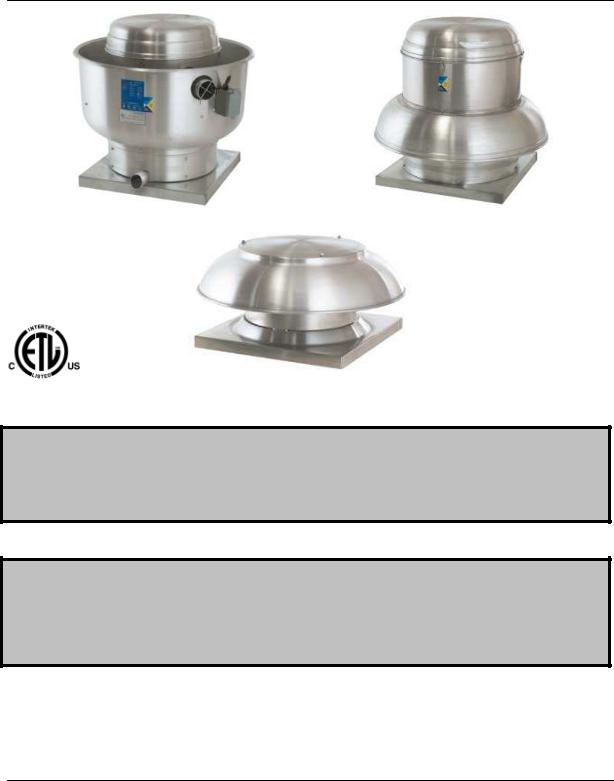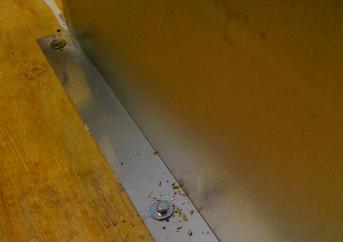CaptiveAire HRE, NCA-FA, HFA Installation Manual

Power Roof Ventilator
Installation, Operation, and Maintenance Manual
Up-blast Centrifugal Fan |
Down-blast Centrifugal Fan |
Axial Fan
RECEIVING AND INSPECTION
Upon receiving unit, check for any interior and exterior damage, and if found, report it immediately to the carrier. Also check that all accessory items are accounted for and are damage free. Turn the blower wheel by hand to verify free rotation and check the damper (if supplied) for free operation.
WARNING!!
Installation of this ventilator should only be performed by a qualified professional who has read and understands these instructions and is familiar with proper safety precautions. Improper installation poses serious risk of injury due to electric shock, contact with rotating equipment, and other potential hazards. Read this manual thoroughly before installing or servicing this equipment. ALWAYS disconnect power prior to working on fan.
Save these instructions. This document is the property of the owner of this equipment and is required for future maintenance. Leave this document with the owner when installation or service is complete.
A0011032
July 2010 Rev. 4
2
TABLE OF CONTENTS |
|
WARRANTY............................................................................................................................................ |
4 |
INSTALLATION....................................................................................................................................... |
5 |
Mechanical.......................................................................................................................................... |
5 |
Site Preparation .............................................................................................................................. |
5 |
Roof Mounting................................................................................................................................. |
5 |
Wall Mounting ................................................................................................................................. |
6 |
Curb and Ductwork ......................................................................................................................... |
6 |
Up-Blast Roof Mount Installation ..................................................................................................... |
7 |
Up-Blast Wall Mount Installation ...................................................................................................... |
7 |
Up-Blast Through Wall Installation................................................................................................... |
8 |
Down-Blast Installation .................................................................................................................... |
8 |
Typical Hinge Kit ............................................................................................................................. |
9 |
Typical Grease Box Installation ....................................................................................................... |
9 |
Electrical ........................................................................................................................................... |
10 |
Copper Wire Ampacity .................................................................................................................. |
10 |
Speed Control ............................................................................................................................... |
11 |
Motorized Damper......................................................................................................................... |
11 |
Fan to Building Wiring Connection................................................................................................. |
12 |
OPERATION ......................................................................................................................................... |
13 |
Start Up............................................................................................................................................. |
13 |
Special Tools Required ................................................................................................................. |
13 |
Start Up Procedure ....................................................................................................................... |
13 |
Pulley Adjustment (Belt Drive Fans) .............................................................................................. |
14 |
Pulley Alignment ........................................................................................................................... |
14 |
Proper Belt Tension ...................................................................................................................... |
14 |
Pulley Setscrew Torque................................................................................................................. |
14 |
Pulley Combination Chart.............................................................................................................. |
15 |
Troubleshooting ................................................................................................................................ |
16 |
Troubleshooting Chart................................................................................................................... |
16 |
MAINTENANCE .................................................................................................................................... |
17 |
General Maintenance ........................................................................................................................ |
17 |
Bearing Grease Charge................................................................................................................. |
17 |
Bearing Grease Type .................................................................................................................... |
17 |
2 weeks after startup ......................................................................................................................... |
17 |
Every 3 months ................................................................................................................................. |
18 |
Yearly................................................................................................................................................ |
18 |
Start-Up and Maintenance Documentation ........................................................................................ |
20 |
Job Information ............................................................................................................................. |
20 |
Fan Unit Information...................................................................................................................... |
20 |
Maintenance Record ..................................................................................................................... |
20 |
Factory Service Department .......................................................................................................... |
20 |
3
WARRANTY
This equipment is warranted to be free from defects in materials and workmanship, under normal use and service, for a period of 12 months from date of shipment. This warranty shall not apply if:
1.The equipment is not installed by a qualified installer per the MANUFACTURER’S installation instructions shipped with the product,
2.The equipment is not installed in accordance with federal, state and local codes and regulations,
3.The equipment is misused or neglected,
4.The equipment is not operated within its published capacity,
5.The invoice is not paid within the terms of the sales agreement.
The MANUFACTURER shall not be liable for incidental and consequential losses and damages potentially attributable to malfunctioning equipment. Should any part of the equipment prove to be defective in material or workmanship within the 12-month warranty period, upon examination by the MANUFACTURER, such part will be repaired or replaced by MANUFACTURER at no charge. The BUYER shall pay all labor costs incurred in connection with such repair or replacement. Equipment shall not be returned without MANUFACTURER’S prior authorization and all returned equipment shall be shipped by the BUYER, freight prepaid to a destination determined by the MANUFACTURER.
4
INSTALLATION
It is imperative that this unit is installed and operated with the designed airflow and electrical supply in accordance with this manual. If there are any questions about any items, please call the service department at 1-866-784-6900 for warranty and technical support issues.
Mechanical
WARNING: DO NOT RAISE VENTILATOR BY THE HOOD, BLOWER OR MOTOR SHAFT, OR BEARINGS – USE LIFTING LUGS PROVIDED OR A SLING
Site Preparation
1.Provide clearance around installation site to safely rig and lift equipment into its final position. Supports must adequately support equipment. Refer to manufacturer’s estimated weights.
2.Consider general service and installation space when locating unit.
3.Locate unit close to the space it will serve to reduce long, twisted duct runs.
4.The fan discharge must be located at least 10 feet away from any supply intakes. The fan discharge shall be located in accordance with the applicable building code provisions.
Roof Mounting
1.Ventilators are designed for installation atop a prefabricated or factory built roof curb. Follow manufacturer’s instructions for proper curb installation.
2.If a backdraft damper is required, it should be secured within the curb using sheet metal screws, to the bottom of a damper box or damper support flanges located below the roof deck.
CAUTION: NFPA-96 RECOMMENDS THAT DAMPERS SHOULD NOT BE INSTALLED WHEN EXHAUSTER IS USED FOR REMOVAL OF SMOKE AND GREASE LADEN VAPORS FROM COMMERCIAL KITCHEN EQUIPMENT. CONSULT STATE AND LOCAL CODES FOR DETAILED REQUIREMENTS.
3.If an up-blast fan is used for kitchen hood exhaust, ensure discharge is at least 40 inches above the roof surface in accordance with NFPA96.
4.On an up-blast fan, normally the power cord is brought through the conduit tube located on the top skirt on the outside of the unit.
5.Secure ventilator curb through vertical portion of the ventilator base assembly flange using a minimum of eight (8) lug screws, anchor bolts, or other suitable fasteners (not furnished).
6.Before connecting fan motor to power source verify power line wiring is de-energized.
7.Connect power supply wiring to the motor as indicated on the motor nameplate or terminal box cover. Make certain that the power source is compatible with the requirements of your equipment.
8.Before powering up fan check ventilator wheel for free rotation.
9.Check all fasteners for tightness.
10.Re-install motor dome.
11.A drain pipe is provided for single-point drainage of water and residue on up-blast fans. The drain pipe should be positioned towards the roof slope. Some means for collection of this residue must be provided, either a container directly under the trough or use of an adapter and pipe to carry the residue to a remote collection point. An optional down spout and grease collection box is available as an accessory item for up-blast fans.
5

Wall Mounting
1.The same instructions, warnings and notes found under Roof Mounting section will apply. Refer to steps 2 and 3, and steps 5 through 8.
2.Masonry Wall: Around the wall opening install an angle iron frame at least 2” x2” x ¼”. Frame should be approximately 1/2” smaller than the inside base dimension of the ventilator. Secure the lead cinch type anchors with non-ferrous bolts (3 per side). The ventilator should be mounted to the mounting angle with self-taping sheet metal screws (3 per side).
3.Wood Sidings: Around the wall opening install a wooden frame 2” high x 2” wide. Frame should be approximately 1/2” smaller than the inside base dimension of the ventilator. Secure with counter-sunk expansion type lag bolts (3 per side). The ventilator should then be mounted to the mounting frame with the square head wood screws (3 per side) 3/8” minimum.
4.Steel wall mount brackets are also available as a factory option for the fan.
5.The mounting flange connections should be coated with a suitable caulking compound or an approved waterproof mastic sealer.
6.Wall mount application is not recommended from fans with wheels 30” or larger.
IMPORTANT: OSHA REGULATIONS REQUIRE THE VENTILATOR TO BE MOUNTED AT LEAST EIGHT (8) FEET ABOVE GROUND OR FLOOR LEVEL.
Curb and Ductwork
This fan was specified for a specific CFM and static pressure. The ductwork attached to this unit will significantly affect the airflow performance. Flexible ductwork and square elbows should not be used. Also, transitions and turns in ductwork near
the fan inlet will cause system effect and will drastically increase the static pressure and reduce airflow. Follow SMACNA guides and recommendations for the remaining duct run. Fans designed for rooftop installation should be installed on a prefabricated or factory built roof curb. Follow curb manufacturer’s instructions for proper curb installation. Curbs should be connected to structural roof members with at least four (3) lug screws, anchor bolts, or other suitable fasteners (not furnished) per curb flange. Curb flanges should be caulked to roof.
The fan should be installed on a curb and/or
rail elevated not less than 14” above any surface. Be sure duct connection and fan outlet are properly aligned and sealed. Secure fan to curb through vertical portion of the ventilator base assembly flange using a minimum of eight (8) lug screws, anchor bolts, or other suitable fasteners (not furnished). Shims may be required depending upon curb installation and roofing material. Check all fasteners for tightness. The diagrams below show different mechanical installation configurations.
6
